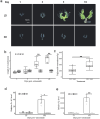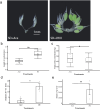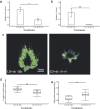Krüppel homolog 1 mediates juvenile hormone action to suppress photoperiodic reproductive diapause-related phenotypes in the female Chrysoperla nipponensis (Neuroptera: Chrysopidae)
- PMID: 40116215
- PMCID: PMC11926538
- DOI: 10.1093/jisesa/ieaf027
Krüppel homolog 1 mediates juvenile hormone action to suppress photoperiodic reproductive diapause-related phenotypes in the female Chrysoperla nipponensis (Neuroptera: Chrysopidae)
Abstract
Juvenile hormone (JH) has been revealed to be a critical factor in regulating photoperiod reproductive diapause in various insect species, however, little information is known about the detailed mechanisms. In this study, we investigated the roles of JH signaling in photoperiod reproductive diapause in a green lacewing, Chrysoperla nipponensis (Okamoto), which is a potentially important biological control predator. Our results showed that the short-day condition induces a diapause state including JH synthesis suppression, ovarian development arrest, and triglyceride accumulation. The interference of JH response genes, Krüppel homolog 1 (Kr-h1), in reproductive females exhibited a diapause-related phenotype such as ovarian development arrest and larger triglyceride storage. Exogenous JH III suppresses diapause to promote ovarian development and inhibit triglyceride synthesis. However, exogenous JH III fails to rescue the Kr-h1-silenced phenotype. Accordingly, our results demonstrate the critical role of Kr-h1 in regulating JH signaling to promote reproduction.
Keywords: Krüppel-homolog 1; green lacewing; juvenile hormone; photoperiod; reproductive diapause.
© The Author(s) 2025. Published by Oxford University Press on behalf of Entomological Society of America.
Figures






Similar articles
-
Krüppel homolog 1 regulates photoperiodic reproductive plasticity in the cabbage beetle Colaphellus bowringi.Insect Biochem Mol Biol. 2021 Jul;134:103582. doi: 10.1016/j.ibmb.2021.103582. Epub 2021 Apr 24. Insect Biochem Mol Biol. 2021. PMID: 33905880
-
Juvenile hormone regulates reproductive diapause through both canonical and noncanonical pathways in the bean bug Riptortus pedestris.Insect Biochem Mol Biol. 2025 Feb;177:104233. doi: 10.1016/j.ibmb.2024.104233. Epub 2024 Nov 30. Insect Biochem Mol Biol. 2025. PMID: 39622304
-
Juvenile hormone biosynthetic genes are critical for regulating reproductive diapause in the cabbage beetle.Insect Biochem Mol Biol. 2021 Dec;139:103654. doi: 10.1016/j.ibmb.2021.103654. Epub 2021 Sep 24. Insect Biochem Mol Biol. 2021. PMID: 34571141
-
Methoprene-tolerant and Krüppel homolog 1 are actors of juvenile hormone-signaling controlling the development of male sexual behavior in the moth Agrotis ipsilon.Horm Behav. 2023 Apr;150:105330. doi: 10.1016/j.yhbeh.2023.105330. Epub 2023 Feb 13. Horm Behav. 2023. PMID: 36791650 Review.
-
Juvenile hormone signaling - a mini review.Insect Sci. 2019 Aug;26(4):600-606. doi: 10.1111/1744-7917.12614. Epub 2018 Jul 18. Insect Sci. 2019. PMID: 29888456 Review.
References
-
- Chang YF, Tauber MJ, Tauber CA.. 1995. Storage of the mass-produced predator Chrysoperla carnea (Neuroptera: Chrysopidae): influence of photoperiod, temperature, and diet. Environ. Entomol. 24:1365–1374. https://doi.org/10.1093/ee/24.5.1365 - DOI
-
- Chen ZZ, Liu LY, Liu SY, et al.2017. Response of Chrysoperla nipponensis (Okamoto) (Neuroptera: Chrysopidae) under long and short photoperiods. J. Insect Sci. 17:35. https://doi.org/10.1093/jisesa/iex005 - DOI - PMC - PubMed
-
- Chen ZZ, Wang X, Kong X, et al.2023. Quantitative transcriptomic and proteomic analyses reveal the potential maintenance mechanism of female adult reproductive diapause in Chrysoperla nipponensis. Pest Manag. Sci. 79:1897–1911. https://doi.org/10.1002/ps.7375 - DOI - PubMed
-
- de Kort CAD. 1990. Thirty-five years of diapause research with the Colorado potato beetle. Entomol. Exp. Applic 56:1–13.
-
- Denlinger DL. 2002. Regulation of diapause. Annu. Rev. Entomol. 47:93–122. https://doi.org/10.1146/annurev.ento.47.091201.145137 - DOI - PubMed
MeSH terms
Substances
Grants and funding
LinkOut - more resources
Full Text Sources

